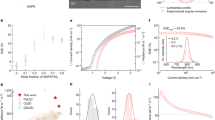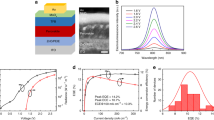Abstract
Perovskite nanocrystals are exceptional candidates for light-emitting diodes (LEDs). However, they are unstable in the solid film and tend to degrade back to the bulk phase, which undermines their potential for LEDs. Here we demonstrate that perovskite nanocrystals stabilized in metal–organic framework (MOF) thin films make bright and stable LEDs. The perovskite nanocrystals in MOF thin films can maintain the photoluminescence and electroluminescence against continuous ultraviolet irradiation, heat and electrical stress. As revealed by optical and X-ray spectroscopy, the strong emission originates from localized carrier recombination. Bright LEDs made from perovskite-MOF nanocrystals are demonstrated with a maximum external quantum efficiency of over 15% and a high brightness of over 105 cd m−2 after the device reaches stabilization. During LED operation, the nanocrystals can be well preserved, free of ion migration or crystal merging through protection by the MOF matrix, leading to a stable performance over 50 hours.
This is a preview of subscription content, access via your institution
Access options
Access Nature and 54 other Nature Portfolio journals
Get Nature+, our best-value online-access subscription
$29.99 / 30 days
cancel any time
Subscribe to this journal
Receive 12 print issues and online access
$209.00 per year
only $17.42 per issue
Buy this article
- Purchase on Springer Link
- Instant access to full article PDF
Prices may be subject to local taxes which are calculated during checkout




Similar content being viewed by others
Data availability
The data that support the plots and other findings within this report are available from the corresponding authors upon reasonable request.
References
Kovalenko, M. V., Protesescu, L. & Bodnarchuk, M. I. Properties and potential optoelectronic applications of lead halide perovskite nanocrystals. Science 358, 745–750 (2017).
Dou, L. et al. Atomically thin two-dimensional organic-inorganic hybrid perovskites. Science 349, 1518–1521 (2015).
Kumar, S. et al. Ultrapure green light-emitting diodes using two-dimensional formamidinium perovskites: achieving recommendation 2020 color coordinates. Nano Lett. 17, 5277–5284 (2017).
Droseros, N. et al. Origin of the enhanced photoluminescence quantum yield in MAPbBr3 perovskite with reduced crystal size. ACS Energy Lett. 3, 1458–1466 (2018).
Ji, S. et al. Near-unity red Mn2+ photoluminescence quantum yield of doped CsPbCl3 nanocrystals with Cd incorporation. J. Phys. Chem. Lett. 11, 2142–2149 (2020).
Dutta, A., Behera, R. K., Pal, P., Baitalik, S. & Pradhan, N. Near-unity photoluminescence quantum efficiency for all CsPbX3 (X = Cl, Br, and I) perovskite nanocrystals: a generic synthesis approach. Angew. Chem. Int. Ed. 58, 5552–5556 (2019).
Di Stasio, F., Christodoulou, S., Huo, N. & Konstantatos, G. Near-unity photoluminescence quantum yield in CsPbBr3 nanocrystal solid-state films via postsynthesis treatment with lead bromide. Chem. Mater. 29, 7663–7667 (2017).
Polavarapu, L., Nickel, B., Feldmann, J. & Urban, A. S. Advances in quantum-confined perovskite nanocrystals for optoelectronics. Adv. Energy Mater. 7, 1700267 (2017).
Baranowski, M. & Plochocka, P. Excitons in metal-halide perovskites. Adv. Energy Mater. 10, 1903659 (2020).
Liu, C. et al. Asynchronous photoexcited electronic and structural relaxation in lead-free perovskites. J. Am. Chem. Soc. 141, 13074–13080 (2019).
Tsai, H. et al. High-efficiency two-dimensional Ruddlesden–Popper perovskite solar cells. Nature 536, 312–316 (2016).
Bai, S. et al. Planar perovskite solar cells with long-term stability using ionic liquid additives. Nature 571, 245–250 (2019).
Lei, Y. et al. A fabrication process for flexible single-crystal perovskite devices. Nature 583, 790–795 (2020).
Huang, H.-H. et al. A simple one-step method with wide processing window for high-quality perovskite mini-module fabrication. Joule 5, 958–974 (2021).
Zhao, B. et al. High-efficiency perovskite–polymer bulk heterostructure light-emitting diodes. Nat. Photon. 12, 783–789 (2018).
Lin, K. et al. Perovskite light-emitting diodes with external quantum efficiency exceeding 20 per cent. Nature 562, 245–248 (2018).
Cao, Y. et al. Perovskite light-emitting diodes based on spontaneously formed submicrometre-scale structures. Nature 562, 249–253 (2018).
Protesescu, L. et al. Nanocrystals of cesium lead halide perovskites (CsPbX3, X = Cl, Br, and I): novel optoelectronic materials showing bright emission with wide color gamut. Nano Lett. 15, 3692–3696 (2015).
Jia, Y., Kerner, R. A., Grede, A. J., Rand, B. P. & Giebink, N. C. Continuous-wave lasing in an organic–inorganic lead halide perovskite semiconductor. Nat. Photon. 11, 784–788 (2017).
Zhu, H. et al. Lead halide perovskite nanowire lasers with low lasing thresholds and high quality factors. Nat. Mater. 14, 636–642 (2015).
Yakunin, S. et al. Low-threshold amplified spontaneous emission and lasing from colloidal nanocrystals of caesium lead halide perovskites. Nat. Commun. 6, 8056 (2015).
Chen, Q. et al. All-inorganic perovskite nanocrystal scintillators. Nature 561, 88–93 (2018).
Mykhaylyk, V. B., Kraus, H. & Saliba, M. Bright and fast scintillation of organolead perovskite MAPbBr3 at low temperatures. Mater. Horiz. 6, 1740–1747 (2019).
Akkerman, Q. A., Rainò, G., Kovalenko, M. V. & Manna, L. Genesis, challenges and opportunities for colloidal lead halide perovskite nanocrystals. Nat. Mater. 17, 394–405 (2018).
Gomez, L. et al. Extraordinary interfacial stitching between single all-inorganic perovskite nanocrystals. ACS Appl. Mater. Interfaces 10, 5984–5991 (2018).
Huang, S. et al. Morphology evolution and degradation of CsPbBr3 nanocrystals under blue light-emitting diode Illumination. ACS Appl. Mater. Interfaces 9, 7249–7258 (2017).
Li, J. et al. Ultraviolet light induced degradation of luminescence in CsPbBr3 perovskite nanocrystals. Mater. Res. Bull. 102, 86–91 (2018).
Park, J. H. et al. Surface ligand engineering for efficient perovskite nanocrystal-based light-emitting diodes. ACS Appl. Mater. Interfaces 11, 8428–8435 (2019).
Zhou, Q. et al. In situ fabrication of halide perovskite nanocrystal-embedded polymer composite films with enhanced photoluminescence for display backlights. Adv. Mater. 28, 9163–9168 (2016).
Pan, A. et al. Nanorod suprastructures from a ternary graphene oxide–polymer–CsPbX3 perovskite nanocrystal composite that display high environmental stability. Nano Lett. 17, 6759–6765 (2017).
Raja, S. N. et al. Encapsulation of perovskite nanocrystals into macroscale polymer matrices: enhanced stability and polarization. ACS Appl. Mater. Interfaces 8, 35523–35533 (2016).
Wei, Y. et al. In situ light-initiated ligands cross-Linking enables efficient all-solution-processed perovskite light-emitting diodes. J. Phys. Chem. Lett. 11, 1154–1161 (2020).
Zhang, C. et al. Conversion of invisible metal-organic frameworks to luminescent perovskite nanocrystals for confidential information encryption and decryption. Nat. Commun. 8, 1138 (2017).
He, H. et al. Confinement of perovskite-QDs within a single MOF crystal for significantly enhanced multiphoton excited luminescence. Adv. Mater. 31, 1806897 (2019).
Zhang, Q., Wu, H., Lin, W., Wang, J. & Chi, Y. Enhancing air-stability of CH3NH3PbBr3 perovskite quantum dots by in-situ growth in metal-organic frameworks and their applications in light emitting diodes. J. Solid State Chem. 272, 221–226 (2019).
Hou, J. et al. Intermarriage of halide perovskites and metal–organic framework crystals. Angew. Chem. Int. Ed. 59, 19434–19449 (2020).
Zhang, C., Li, W. & Li, L. Metal halide perovskite nanocrystals in metal–organic framework host: not merely enhanced stability. Angew. Chem. Int. Ed. 60, 7488–7501 (2021).
Sadeghzadeh, H. & Morsali, A. Sonochemical synthesis and structural characterization of a nano-structure Pb(II) benzentricarboxylate coordination polymer: new precursor to pure phase nanoparticles of Pb(II) oxide. J. Coord. Chem. 63, 713–720 (2010).
Mao, L., Stoumpos, C. C. & Kanatzidis, M. G. Two-dimensional hybrid halide perovskites: principles and promises. J. Am. Chem. Soc. 141, 1171–1190 (2019).
Zhang, F. et al. Brightly luminescent and color-tunable colloidal CH3NH3PbX3 (X = Br, I, Cl) quantum dots: potential alternatives for display technology. ACS Nano 9, 4533–4542 (2015).
Makarov, N. S. et al. Spectral and dynamical properties of single excitons, biexcitons, and trions in cesium–lead-halide perovskite quantum dots. Nano Lett. 16, 2349–2362 (2016).
Woo, H. C. et al. Temperature-dependent photoluminescence of CH3NH3PbBr3 perovskite quantum dots and bulk counterparts. J. Phys. Chem. Lett. 9, 4066–4074 (2018).
Wang, D. et al. Photon-induced carrier recombination in the nonlayered-structured hybrid organic-inorganic perovskite nano-sheets. Opt. Express 26, 27504–27514 (2018).
Shi, Z. et al. Strategy of solution-processed all-inorganic heterostructure for humidity/temperature-stable perovskite quantum dot light-emitting diodes. ACS Nano 12, 1462–1472 (2018).
Liu, C., Tsai, H., Nie, W., Gosztola, D. J. & Zhang, X. Direct spectroscopic observation of the hole polaron in lead halide perovskites. J. Phys. Chem. Lett. 11, 6256–6261 (2020).
Tsai, H. et al. Critical role of organic spacers for bright 2D layered perovskites light-emitting diodes. Adv. Sci. 7, 1903202 (2020).
Yi, C. et al. Intermediate-phase-assisted low-temperature formation of γ-CsPbI3 films for high-efficiency deep-red light-emitting devices. Nat. Commun. 11, 4736 (2020).
Suzuki, K. Quantaurus-QY: absolute photoluminescence quantum yield spectrometer. Nat. Photon. 5, 247–247 (2011).
Hou, C.-H. et al. Validated analysis of component distribution inside perovskite solar cells and its utility in unveiling factors of device performance and degradation. ACS Appl. Mater. Interfaces 12, 22730–22740 (2020).
Acknowledgements
S.S. and W.N. acknowledge support from the Laboratory Directed Research and Development programme at Los Alamos National Laboratory (LANL). H.T. acknowledges financial support of the J. Robert Oppenheimer Distinguished Postdoc Fellowship at LANL. R.A.V. acknowledges support from the National Academy of Sciences Ford Foundation Fellowship and the National Science Foundation Graduate Research Fellowship Program (NSFGRFP; grant number DGE–1656518). H.-H.H. acknowledges financial support from the Ministry of Science and Technology (MOST 108-2113-M-002-015-MY3 and 108-2911-I-002-561), Academia Sinica (AS-iMATE-109-31) and the Center of Atomic Initiative for New Materials, National Taiwan University from the Featured Areas Research Center Program within the framework of the Higher Education Sprout Project by the Ministry of Education, Taiwan. This work was performed, in part, at the Center for Integrated Nanotechnologies, an Office of Science User Facility operated for the US Department of Energy (DOE) Office of Science by LANL (contract number 89233218CNA000001). Part of this research used sector 8-ID-E and sector 11-ID-D of the Advanced Photon Source and Center for Nanoscale Materials, Office of Science User Facilities, supported by the US DOE, Office of Science, Office of Basic Energy Sciences, under contract number DE-AC02-06CH11357. Part of work was supported by Laboratory Directed Research and Development funding from Argonne National Laboratory, provided by the Director, Office of Science, of the US DOE under contract number DE-AC02-06CH11357. This research used resources of the Center for Functional Nanomaterials, which is a US DOE Office of Science Facility, at Brookhaven National Laboratory under contract number DE-SC0012704. Part of this work was performed at the Stanford Nano Shared Facilities, supported by the National Science Foundation under award ECCS-1542152.
Author information
Authors and Affiliations
Contributions
H.T. and W.N. conceived the idea, designed experiments, analysed data and wrote the paper. H.T. performed material synthesis, structure characterization and carried out the device fabrication and characterization; R.A.V. and W.H. performed the TEM characterization under the supervision of Y.C.; C.L. and X.Z. performed the XAS measurements and analysed the data. X.W. and G.W. performed the optical transient absorption measurements and analysed the data. S.S., M.L., M.C. and X.M. contributed to the optical spectroscopy measurements and analysed the data. C.-H.H. and H.-H.H. helped with characterizations and the atomic force microscopy and ToF-SIMs analysis. All authors discussed the results and co-wrote the manuscript.
Corresponding authors
Ethics declarations
Competing interests
The authors declare no competing interests.
Additional information
Peer review information Nature Photonics thanks Dawei Di and the other, anonymous, reviewer(s) for their contribution to the peer review of this work.
Publisher’s note Springer Nature remains neutral with regard to jurisdictional claims in published maps and institutional affiliations.
Supplementary information
Supplementary Information
Supplementary Figs. 1–29 and Table 1.
Rights and permissions
About this article
Cite this article
Tsai, H., Shrestha, S., Vilá, R.A. et al. Bright and stable light-emitting diodes made with perovskite nanocrystals stabilized in metal–organic frameworks. Nat. Photon. 15, 843–849 (2021). https://doi.org/10.1038/s41566-021-00857-0
Received:
Accepted:
Published:
Issue Date:
DOI: https://doi.org/10.1038/s41566-021-00857-0
This article is cited by
-
Vapour-deposited perovskite light-emitting diodes
Nature Reviews Materials (2024)
-
Potential and perspectives of halide perovskites in light emitting devices
Nano Convergence (2023)
-
Handwriting of perovskite optoelectronic devices on diverse substrates
Nature Photonics (2023)
-
Metal–organic framework scintillators detect radioactive gases
Nature Photonics (2023)
-
Modulator-directed assembly of hybrid composites based on metal-organic frameworks and upconversion nanoparticles
Nano Research (2023)



